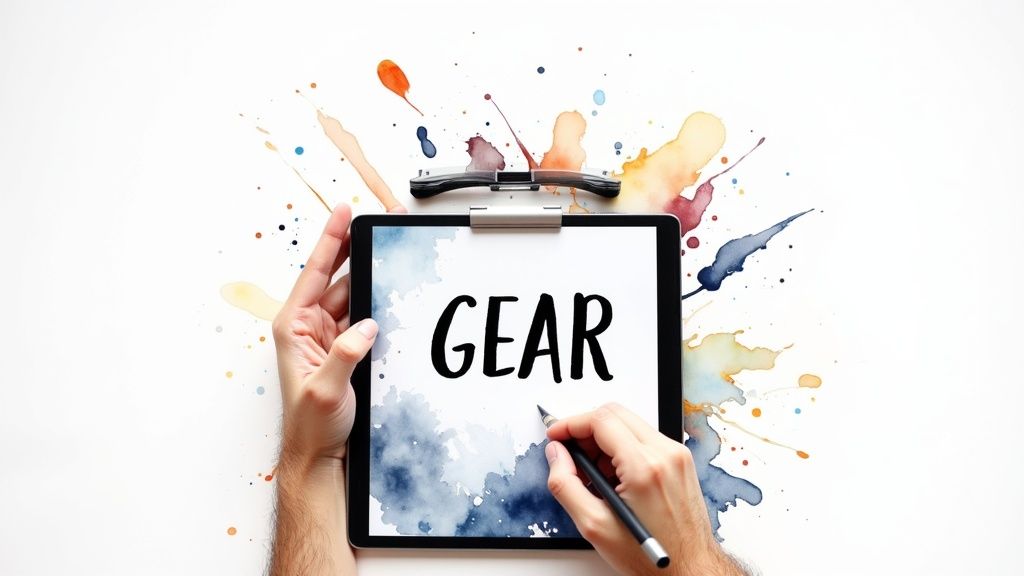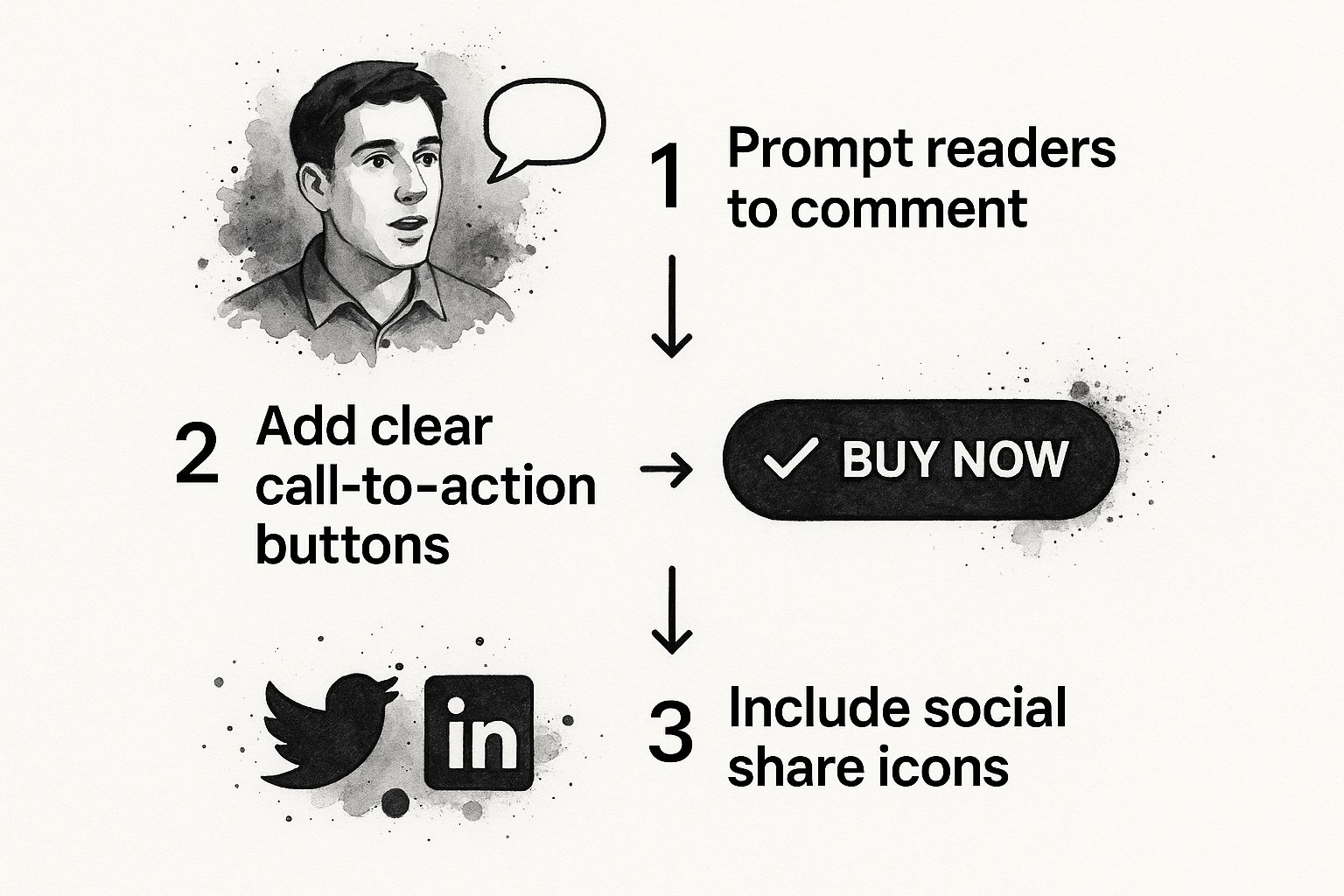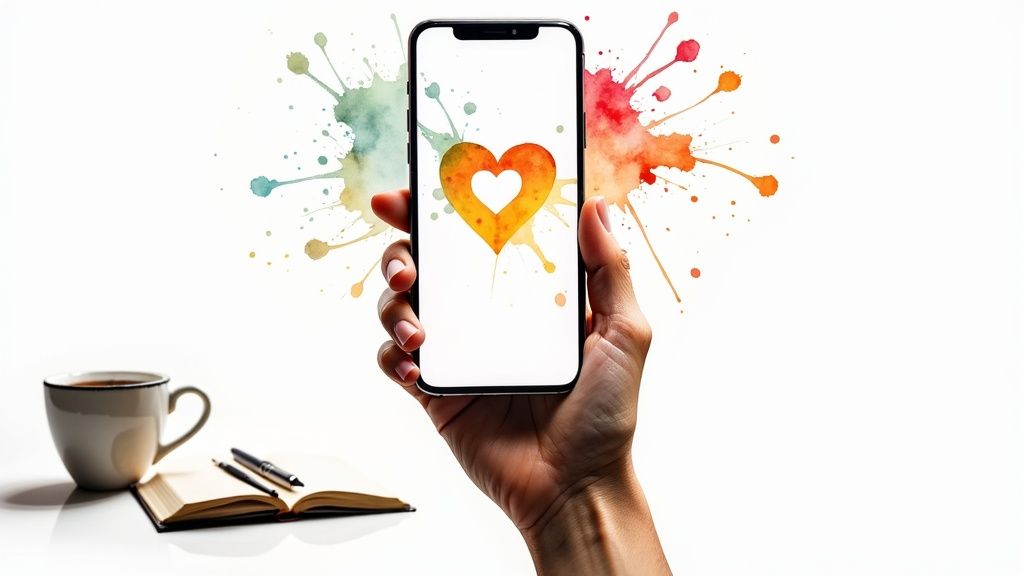Forget trying to catch lightning in a bottle. Making content that people actually want to share isn't about luck or some random fluke; it's a science. When you break it down, it really comes down to three things: sparking an emotional connection, giving your audience something of tangible value, and having a smart distribution strategy. Get this blueprint right, and you'll be creating content people feel compelled to pass along.
The Blueprint for Shareable Content in Today's World

The old "publish and pray" method is dead. If you want to learn how to create shareable content, you need to accept that virality isn't an accident—it's engineered. Success is all about architecting an experience that hits home so hard with your audience that sharing it feels like a natural next step.
This isn't just about churning out articles or videos. It’s about forging real connections in an incredibly noisy digital world. When your content makes someone feel seen, entertained, or just plain smarter, they’re far more likely to share it. Why? Because it reflects on them and reinforces their own identity.
Why Old Methods Are Failing
Let’s be real: the sheer firehose of content hitting the internet every single day makes it almost impossible to stand out without a solid game plan. Your audience has gotten incredibly good at tuning out generic, fluffy nonsense. Any strategy that works today has to be built on a foundation of genuine value.
The big shift is from thinking "brand-first" to "audience-first." Stop asking, "What do we want to say?" Start asking, "What does our audience want to share, and why?"
Before you even think about getting your content out there, you have to get the fundamentals right. That means sticking to proven content creation best practices to make sure you're building on solid ground from the get-go.
Core Pillars of Shareable Content
To really nail this, you have to focus on the core components that make people want to hit that share button. I've broken them down into this quick table to give you a bird's-eye view.
| Pillar | Key Objective | Example Tactic |
|---|---|---|
| Emotional Connection | Elicit a strong feeling like joy, awe, or surprise. | Tell a relatable personal story or use powerful, evocative visuals. |
| Tangible Value | Provide actionable advice, useful data, or entertainment. | Create a how-to guide that solves a specific problem or a data-backed report. |
| Smart Distribution | Get the content in front of the right people at the right time. | Identify and engage with niche communities on social media where your audience hangs out. |
Thinking through these pillars for every piece of content you create is what separates the stuff that gets ignored from the stuff that gets shared.
The Modern Content Landscape
The opportunity here is massive. As of 2025, there are around 5.42 billion social media users across the globe. That's a mind-boggling potential audience. With the average person juggling nearly seven different social networks, there are more channels than ever for your content to travel. For more sharp insights on growth, the folks at https://rebelgrowth.com/blog have some great resources.
This is where technology gives you a serious edge. AI tools are no longer just a "nice-to-have"; they're a core part of the modern content toolkit. In fact, a staggering 90% of businesses using generative AI are saving significant time on production. Better yet, 73% are seeing real lifts in engagement from content created with AI assistance. This isn't just hype; it's about using the right tools to work smarter and get better results.
Crafting Content That Creates an Emotional Spark
If your content doesn't make people feel something, it's going to be ignored. It's as simple as that. The real secret to creating wildly shareable content isn't some complex growth hack; it's about forging a genuine human connection.
When you manage to spark a powerful emotion, people don't just read or watch your content—they own it. A share becomes their way of saying, "This is me. This is what I believe in."
Think about it. Content that triggers a strong emotional response is just begging to be shared. And I'm not just talking about making someone happy or sad. The key is to tap into what psychologists call high-arousal emotions—the ones that make our hearts beat a little faster. Awe, amusement, inspiration, even a bit of righteous anger. These are the feelings that demand an outlet, and more often than not, that outlet is the share button.
Moving Beyond Generic Feelings
It's one thing to say "be emotional," but what does that actually look like in practice? It starts with getting inside the psychology of why people share in the first place. People share content that helps them define who they are and strengthen their bonds with others.
This is what Jonah Berger calls social currency. You're giving people something valuable they can "spend" in their social circles to boost their own reputation. Does your content make them look smart? Funny? In-the-know? Answering that is your first step toward creating something people are desperate to pass along.
Let's break down some of the most potent emotional triggers I've seen work time and time again:
- Awe: This is that feeling of wonder you get when you see something vast or profound, like a stunning nature documentary or a mind-bending scientific discovery. Awe makes us feel connected to something bigger than ourselves, and we want to share that feeling.
- Amusement: Laughter is a universal language. Genuinely funny or clever content is probably the most common reason people hit share. It’s a simple, reliable way to spread a little bit of joy.
- Inspiration: Stories about overcoming the odds, achieving the impossible, or just plain helping others are incredibly powerful. This kind of content motivates people and reinforces a shared sense of hope.
"A share is a personal endorsement. When someone shares your content, they are putting their own name and reputation next to your message. Your goal is to create something they are proud to endorse."
Take The Wildlife Trusts' "Wilder Future" campaign. Instead of hitting people over the head with depressing statistics about wildlife decline, they tapped into nostalgia and a sense of shared hope. Their animated video used familiar characters to show that the damage wasn't permanent—that we could fix it.
This emotional pivot was a game-changer. It led to 7,000 new member sign-ups and a massive wave of media coverage. They didn't just present a problem; they made people feel like they could be part of the solution.
Weaving Emotion into Your Storytelling
Storytelling is how you deliver that emotion. A list of facts might be informative, but a story builds a real connection. It taps into our natural sense of empathy and makes us trust the storyteller. When we hear a story that resonates, we're not just passive consumers anymore; we're invested.
So, how can you frame your content as a narrative? Even a simple blog post or infographic can have a story arc:
- The Hook: Kick things off with a relatable problem or an intriguing question that grabs attention from the first second.
- The Build-Up: Introduce some tension or conflict. What’s at stake here? Why should the audience care?
- The Climax: This is where you deliver your core insight, the solution, or the emotional peak. It’s the "aha!" moment.
- The Resolution: End with a clear takeaway or a call to action that feels like the natural, satisfying conclusion to the journey.
Look at Greenpeace's 'Turtle Journey' video. They didn't just rattle off facts about ocean plastic. They told the heart-wrenching story of a turtle family returning home to find it destroyed by pollution and industrial fishing. By framing a huge, abstract issue within a relatable family story, they made it feel personal and urgent.
This powerful storytelling didn't just get views; it got action. It prompted viewers to sign a petition and share the message far and wide, turning them from passive observers into active advocates. Your content can do the exact same thing if you stop just presenting information and start telling a story people can connect with.
Winning with Video and Modern Visual Storytelling

Let's be honest. In a feed overflowing with text, visuals are your single best weapon. If you really want to crack the code on shareable content, you have to start thinking visually from the get-go. A knockout image or a can't-look-away video can stop someone mid-scroll, hitting them with your message way harder than a wall of text ever could. This is where modern visual storytelling isn't just nice—it's necessary.
This whole move toward visuals isn't a fleeting trend. It's a seismic shift in how people take in information. And right now, video is the undisputed king of engagement. If you're not making videos, you're pretty much choosing to be invisible.
The Unstoppable Rise of Short-Form Video
Platforms like TikTok and Instagram Reels have totally rewired what audiences expect. People now crave fast, energetic, and real video snippets that cut straight to the chase. The era of long, hyper-polished corporate videos is dead and gone. Today, it’s all about creating stuff that feels like it belongs on the platform where people are watching it.
And for brands, this format is a goldmine. A quick 15-second clip can show off a product feature, share a glowing customer testimonial, or tell a tiny story that triggers a big emotional response. The best part? The barrier to entry has never been lower. Your phone is a production studio, and raw authenticity almost always trumps a big production budget.
The goal isn't just to make a video; it's to create a narrative that hooks the viewer in the first three seconds. If you fail to grab their attention immediately, they're gone.
Picture a small coffee shop. Instead of just posting another photo of a latte, they could drop a Reel showing the whole journey—from grinding the fresh beans to the final, beautiful latte art pour, all set to a trending song. This kind of content isn't just nice to look at; it gives a behind-the-scenes peek that builds a real connection and feels completely genuine.
Crafting a Compelling Video Narrative
Every great video, no matter how short, tells a story. To make your video content something people have to share, you need to think like a storyteller. Don't just show your product. Show the problem it obliterates or the transformation it makes possible.
Here’s a dead-simple framework for structuring your video stories:
- The Hook: Kick things off with a bold claim, a surprising visual, or a super-relatable problem. This is your three-second window of opportunity.
- The Value: Get to the core message fast. This could be a quick tip, a key benefit, or the emotional payoff you're aiming for.
- The Call-to-Action (CTA): End with a clear, direct instruction. Ask for a comment, a follow, or a click—make it stupidly simple for the viewer to engage more.
This structure works because it respects the viewer's time while giving them a complete, satisfying little package. And the data backs this up big time. In 2025, an estimated 78% of people will prefer learning about new products through short video content. Plus, a massive 88% of marketers report a positive ROI from their video efforts, making it an essential tool for growth. You can dig into more social media trends at Hook Agency if you want the full picture.
Beyond Video: Creating Other Visual Assets
While video may wear the crown, other visual formats are crucial for a well-rounded content strategy. A solid mix of visuals keeps your feed from getting stale and appeals to different audience habits. Learning how to create this kind of variety is a game-changing skill.
Infographics: These are absolute dynamite for breaking down complex data into something clean, scannable, and easy on the eyes. They get shared like crazy because they pack a ton of value, making the person who shares them look smart and helpful. You can even use an AI tool to quickly spin a bunch of stats from a blog post into a slick, professional infographic.
Memes and Reaction Graphics: Don't sleep on the power of humor and relatability. Memes, when you nail the tone and they fit your brand, can trigger huge engagement. They plug you into existing cultural conversations and prove your brand has a pulse.
Custom Graphics and Quotes: Pulling a powerful quote from an article or a customer review and slapping it on a branded template creates a perfect, shareable soundbite. These are quick to make and hammer your key messages home again and again. They crush it on platforms like Instagram and LinkedIn.
By mastering both video and a range of other visual formats, you're basically building a powerful engine that pumps out content people actually want to share. It's all about meeting your audience where they are and speaking their visual language.
Growth Hacking Your Content Distribution
Let's be honest. Creating amazing content that nobody ever sees is a massive waste of time and resources. You can have the most shareable piece in the world, but if you don't get it in front of the right eyeballs, it's dead in the water. It’s time to ditch the old "post and pray" method and start growth hacking your distribution for some serious impact.
This isn't about just throwing your links on social media and hoping for a viral hit. It's about having a deliberate, proactive plan from day one. You need to stop thinking of distribution as an afterthought. It's an essential part of the creation process itself.
Forging Strategic Content Partnerships
One of the absolute fastest ways to get your content seen is by teaming up with others. Think about non-competing brands, influencers, or other creators who serve the exact same audience you do. A smart content partnership can get your work in front of an established, engaged community that already trusts the person you’re collaborating with.
For instance, a SaaS company that sells project management software could easily partner with a well-known productivity blogger. They might co-create a detailed guide on remote team efficiency, and then both promote it to their own audiences. It's a classic win-win, delivering huge value to everyone's followers while doubling the promotional horsepower.
The secret here is finding partners whose brand and values really line up with yours. The collaboration has to feel authentic and genuinely helpful to everyone, especially the reader.
Identify and Activate Your Super-Sharers
In every niche, there are certain people who are just natural amplifiers. I call them super-sharers. These are the folks who consistently share high-quality content and have a real talent for starting conversations. They aren't always big-name influencers; often, they’re passionate experts, community managers, or just your most engaged fans.
Finding these people is a powerful growth hack. You can use social listening tools, or even just manually scan relevant hashtags and online communities to see who is constantly sharing content similar to yours.
Once you know who they are, start building a real relationship. Engage with their posts, leave thoughtful comments, and then, when you have a piece that's a perfect fit for their audience, reach out personally. A simple message like, "Hey, I saw you shared an article on X last week and thought you might find our new data on the topic interesting," works so much better than a generic, blasted email. To really make your content fly, understanding the fundamentals is key, including proven strategies to increase organic traffic.
Orchestrating a Multi-Channel Launch
The day you launch your content really sets the tone for its entire lifespan. A powerful initial push can create a snowball effect of shares and engagement that carries it for weeks. To nail this, you need a coordinated, multi-channel promotion plan ready to go.
- Email Your List: Your subscribers are your most dedicated audience. Always give them the first look.
- Targeted Social Posts: Don’t just copy-paste the same message everywhere. Customize your posts for each platform. Think a professional insight for LinkedIn, a compelling visual for Instagram, or a thought-provoking question for Twitter.
- Community Engagement: Share your work in relevant subreddits, Facebook groups, Slack channels, and forums where your people are actively looking for information. Just remember to be a helpful community member, not a drive-by spammer.
- Repurpose and Syndicate: Take your main content piece and break it down into smaller, bite-sized assets. This infographic, for example, shows a simple flow for encouraging on-page engagement that ultimately leads to more shares.

The visual shows how prompting comments, using clear calls-to-action, and making share icons obvious all work together to boost interaction. By creating these micro-assets, you're giving people more ways and more reasons to share your core message.
This whole distribution push is also crucial for sending traffic where it matters most—your conversion points. The more eyes you get on your content, the more people you can guide toward your high-value landing pages designed to capture that interest. When you pair a fantastic piece of content with a killer distribution strategy, you've built a reliable engine for real growth.
Turning Viral Moments into Sustainable Growth

A viral hit feels fantastic, but let's be real—likes and shares don't pay the bills. The real challenge, and where the money is made, is turning that fleeting burst of attention into something tangible for your business. Unless they directly contribute to leads, sales, and genuine brand loyalty, those shares are just a vanity metric.
This is where you need to connect the dots between the buzz and your business goals. It's all about thinking beyond that initial share. You need a system in place to capture the momentum from a viral piece and channel it effectively. This means strategically weaving calls-to-action (CTAs) into your content without killing the organic vibe that made it shareable in the first place.
From Social Traffic to Owned Platforms
Your number one goal should always be to move your audience from "rented land" (social media) to "owned land" (your website, email list, or app). Why? Because social algorithms can change in a heartbeat, gutting your reach overnight. Your email list, on the other hand, is an asset you completely control. When a piece of content takes off, it's a golden opportunity to grow that asset.
For instance, say a short video guide of yours goes viral on TikTok. A weak CTA is just "follow for more." A much stronger approach is to offer a more detailed, downloadable checklist or e-book on the exact same topic. This gives people a tangible reason to hand over their email address because you're providing even more value.
The moment someone discovers you through a shared piece of content is your best chance to deepen the relationship. Don't waste it by just asking for another like. Guide them toward your own platform where you can build a lasting connection.
To really get this right, you have to engineer these moments from the start. Learning how to make viral content that's built for conversion is a skill. It helps you create content that's not just shareable, but also a powerful lead-generation tool.
Nurturing Your New Audience
Once you’ve captured this new audience on your email list, the work is just beginning. These people found you through one specific piece of content, so they don't know your brand's full story yet. Now it's time to nurture them, introduce them to your core message, and build real trust.
This is where a well-structured email welcome series or a smart retargeting campaign comes in. Send them your best-performing content, share your brand story, and offer exclusive value that makes them genuinely glad they subscribed. This is how you turn a one-time viewer into a loyal fan.
- Segment Your New Leads: Tag subscribers based on the content that brought them in. This lets you send highly relevant follow-ups that speak directly to their original interest.
- Offer Exclusive Value: Give your new subscribers content or offers they can't get anywhere else. This immediately reinforces the value of being on your list.
- Encourage Further Engagement: Ask them to reply to your emails or join a community group. This two-way communication is vital for building a strong, lasting relationship.
The digital world is constantly shifting. In the U.S., a massive 72.5% of the population uses social media, making it a primary channel for discovery. And here's the kicker: 58% of users have made a purchase directly through a social platform. This proves the line from social engagement to revenue is shorter and more direct than ever. Understanding this dynamic is crucial for turning social buzz into measurable sales. You can find more details on American social media usage at Sprinklr.
Common Questions About Shareable Content
Even when you’ve got a solid game plan, a few questions always seem to pop up once you get your hands dirty creating shareable content. Let's walk through some of the most common ones I hear, so you can move forward with total clarity.
How Long Until I See Results?
This is the big one, isn't it? Everyone wants to know when the magic happens. While it's true that a single piece of content can catch fire and go viral overnight, that’s like trying to win the lottery—it's not a real strategy.
Real momentum comes from consistency.
If you're consistently putting these strategies to work, you can realistically expect to see a noticeable bump in your engagement and reach within 2-3 months. The trick is to view every post, every article, and every video as a data point. Pay attention to what resonates and what falls flat, then use that feedback to get smarter with your next piece.
Can B2B Content Be Truly Shareable?
Absolutely. The idea that B2B content is doomed to be dry and stuffy is one of the biggest myths in marketing. The emotional hooks might be different than in B2C, but the fundamental principles of providing value and making a connection are exactly the same.
B2B content really starts to get passed around when it delivers huge practical value, uncovers a unique industry insight, or boldly challenges a long-held belief. Your aim should be to make your reader look like the smartest person in the room for sharing your work with their professional circle.
Think less "cute animal videos" and more "career-changing advice" or "mind-blowing industry stats." Your content should become social currency in a professional context, arming your audience with knowledge that elevates their status among peers.
How Do I Measure the Real ROI?
Vanity metrics like likes and shares feel good, but they don't pay the bills. To get to the real return on investment (ROI) of your content, you need to connect the dots back to your actual business goals.
Here’s what to track:
- Referral Traffic: How many people are actually landing on your website from social media links?
- Click-Through Rates (CTRs): Are people clicking the calls-to-action you’ve baked into your content?
- Attributed Leads: Use UTM parameters to see exactly which content pieces are generating sign-ups and leads.
- Brand Mentions: Keep an eye on how often your brand is being talked about across various platforms.
Ultimately, the true measure of success is how many of those people who first found you through a shared piece of content stick around to become loyal customers. We also handle user data with care; you can always review our commitment to user security by checking our privacy policy.
Ready to turn these insights into action? RebelGrowth provides an all-in-one platform with AI-powered tools to create and schedule social posts, generate high-ranking blog content, and manage your entire growth strategy. Start building content that gets shared and drives real results at https://rebelgrowth.com.
